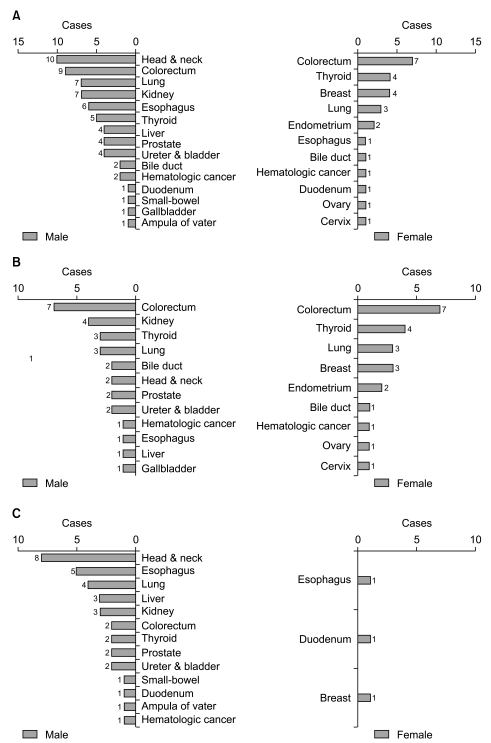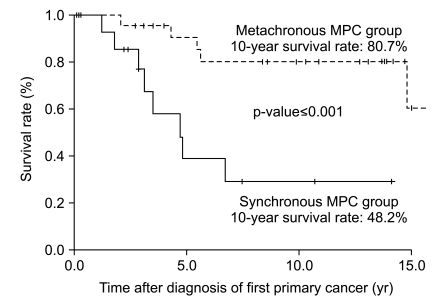Cancer Res Treat.
2010 Dec;42(4):217-224.
Clinicopathologic Features of Metachronous or Synchronous Gastric Cancer Patients with Three or More Primary Sites
- Affiliations
-
- 1Yonsei Cancer Center, Yonsei Cancer Research Institute, Seoul, Korea. hyosong@yuhs.ac
- 2Department of Internal Medicine, Yonsei University College of Medicine, Seoul, Korea.
- 3Brain Korea 21 Project for Medical Science, Seoul, Korea.
Abstract
- PURPOSE
We investigated the clinicopathologic information of patients with gastric cancer with multiple primary cancers (GC-MPC) of three or more sites.
MATERIALS AND METHODS
Between 1995 and 2009, 105,908 patients were diagnosed with malignancy at Severance Hospital, Yonsei University Health System. Of these, 113 (0.1%) patients with MPC of three or more sites were registered, and 41 (36.3%) of these were GC-MPC. We retrospectively reviewed the clinical data and overall survival using the medical records of these 41 GC-MPC patients. We defined synchronous cancers as those occurring within 6 months of the first primary cancer, while metachronous cancers were defined as those occurring more than 6 months later.
RESULTS
Patients with metachronous GC-MPC were more likely to be female (p=0.003) and young than patients with synchronous GC-MPC (p=0.013). The most common cancer sites for metachronous GC-MPC patients were the colorectum, thyroid, lung, kidney and breast, while those for synchronous GC-MPC were the head and neck, esophagus, lung, and kidney. Metachronous GC-MPC demonstrated significantly better overall survival than synchronous GC-MPC, with median overall survival durations of 4.7 and 14.8 years, respectively, and 10-year overall survival rates of 48.2% and 80.7%, respectively (p<0.001).
CONCLUSION
Multiplicity of primary malignancies itself does not seem to indicate a poor prognosis. The early detection of additional primary malignancies will enable proper management with curative intent.
Keyword
MeSH Terms
Figure
Reference
-
1. Otsuji E, Yamaguchi T, Sawai K, Hagiwara A, Taniguchi H, Takahashi T. Recent advances in surgical treatment have improved the survival of patients with gastric carcinoma. Cancer. 1998; 82:1233–1237. PMID: 9529013.
Article2. Ikeda Y, Mori M, Koyanagi N, Wada H, Hayashi H, Tsugawa K, et al. Features of early gastric cancer detected by modern diagnostic technique. J Clin Gastroenterol. 1998; 27:60–62. PMID: 9706772.
Article3. Maehara Y, Okuyama T, Moriguchi S, Orita H, Kusumoto H, Korenaga D, et al. Prophylactic lymph node dissection in patients with advanced gastric cancer promotes increased survival time. Cancer. 1992; 70:392–395. PMID: 1617589.
Article4. Hiyama T, Hanai A, Fujimoto I. Second primary cancer after diagnosis of stomach cancer in Osaka, Japan. Jpn J Cancer Res. 1991; 82:762–770. PMID: 1908843.
Article5. Furukawa H, Hiratsuka M, Iwanaga T, Imaoka S, Kabuto T, Ishikawa O, et al. Treatments for second malignancies after gastrectomy for stomach cancer. Hepatogastroenterology. 1996; 43:194–198. PMID: 8682461.6. Luciani A, Balducci L. Multiple primary malignancies. Semin Oncol. 2004; 31:264–273. PMID: 15112155.
Article7. Németh Z, Czigner J, Iván L, Ujpál M, Barabás J, Szabó G. Quadruple cancer, including triple cancers in the head and neck region. Neoplasma. 2002; 49:412–414. PMID: 12584590.8. Wegner HE. Multiple primary cancers in urologic patients. Audit of 19-year experience in Berlin and review of the literature. Urology. 1992; 39:231–236. PMID: 1546416.
Article9. Salminen E, Pukkala E, Teppo L, Pyrhönen S. Subsequent primary cancers following bladder cancer. Eur J Cancer. 1994; 30A:303–307. PMID: 8204349.
Article10. Rabbani F, Grimaldi G, Russo P. Multiple primary malignancies in renal cell carcinoma. J Urol. 1998; 160:1255–1259. PMID: 9751330.
Article11. Warren S, Gates O. Multiple primary, malignant tumors: a survey of the literature and statistical study. Am J Cancer. 1932; 16:1358–1414.12. Moertel CG. Multiple primary malignant neoplasms: historical perspectives. Cancer. 1977; 40(Suppl 4):1786–1792. PMID: 332330.13. Hayat MJ, Howlader N, Reichman ME, Edwards BK. Cancer statistics, trends, and multiple primary cancer analyses from the Surveillance, Epidemiology, and End Results (SEER) Program. Oncologist. 2007; 12:20–37. PMID: 17227898.
Article14. Hajdu SI, Hajdu EO. Multiple primary malignant tumors. J Am Geriatr Soc. 1968; 16:16–26. PMID: 5634468.
Article15. National Cancer Center. Annual report of Korea Central Cancer Registry. 2009. Goyang: National Cancer Center.16. Inoue M, Tsugane S. Epidemiology of gastric cancer in Japan. Postgrad Med J. 2005; 81:419–424. PMID: 15998815.
Article17. Fujino Y, Mizoue T, Tokui N, Kikuchi S, Hoshiyama Y, Toyoshima H, et al. Cigarette smoking and mortality due to stomach cancer: findings from the JACC Study. J Epidemiol. 2005; 15(Suppl 2):S113–S119. PMID: 16127222.
Article18. Furberg AH, Ambrosone CB. Molecular epidemiology, biomarkers and cancer prevention. Trends Mol Med. 2001; 7:517–521. PMID: 11689338.
Article20. Slaughter DP, Southwick HW, Smejkal W. Field cancerization in oral stratified squamous epithelium; clinical implications of multicentric origin. Cancer. 1953; 6:963–968. PMID: 13094644.
Article21. Begg CB, Zhang ZF, Sun M, Herr HW, Schantz SP. Methodology for evaluating the incidence of second primary cancers with application to smoking-related cancers from the Surveillance, Epidemiology, and End Results (SEER) program. Am J Epidemiol. 1995; 142:653–665. PMID: 7653476.22. Levi F, Randimbison L, Te VC, La Vecchia C. Second primary cancers in patients with lung carcinoma. Cancer. 1999; 86:186–190. PMID: 10391579.
Article23. Ponz de Leon M, Bertario L, Genuardi M, Lanza G, Oliani C, Ranzani GN, et al. Identification and classification of hereditary nonpolyposis colorectal cancer (Lynch syndrome): adapting old concepts to recent advancements. Report from the Italian Association for the study of Hereditary Colorectal Tumors Consensus Group. Dis Colon Rectum. 2007; 50:2126–2134. PMID: 17899274.
Article24. Marrano D, Viti G, Grigioni W, Marra A. Synchronous and metachronous cancer of the stomach. Eur J Surg Oncol. 1987; 13:493–498. PMID: 3691822.25. Moreaux J, Mathey P, Msika S. Gastric adenocarcinoma in the gastric stump after partial gastrectomy. Hepatogastroenterology. 1991; 38:517–521. PMID: 1778582.
- Full Text Links
- Actions
-
Cited
- CITED
-
- Close
- Share
- Similar articles
-
- The Clinicopathologic Features of Synchronous and Metachronous Cancer in Patients with Gastric Cancer
- Clinicopathologic Features and Difference in Prognosis in Synchronous and Metachronous Hepatic Metastases of Gastric Cancer
- Clinical Features of Gastric Cancer Patients with a Second Primary Cancer
- Microsatellite Instability Is Associated with the Clinicopathologic Features of Gastric Cancer in Sporadic Gastric Cancer Patients
- Clinicopathologic characteristics and survival rate in patients with synchronous or metachronous double primary colorectal and gastric cancer




